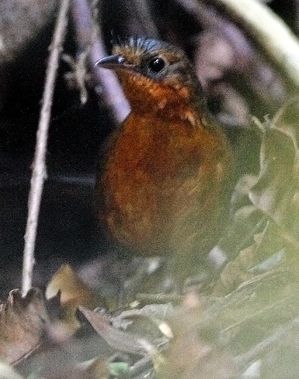
Publisher:
Bonnie King
CONTACT:
Newsroom@Salem-news.com
Advertising:
Adsales@Salem-news.com

~Truth~
~Justice~
~Peace~
TJP
Jan-17-2013 12:58

 TweetFollow @OregonNews
TweetFollow @OregonNews
First Nest Ever Discovered of One of the World's Most Endangered Birds
Salem-News.comTwo Brazilian researchers credited with discovery.
 Stresemann's Bristlefront by Ciro Albano - NE Brazil Birding. Photo may be used with credit. |
(WASHINGTON DC) - The first known nest of one of the world's rarest birds - the Critically Endangered Stresemann's Bristlefront - has been discovered in Brazil. Of perhaps equal significance is that strong evidence of active nestlings was also found.
The Stresemann's Bristlefront is one of the world's most threatened bird species -- unrecorded for 50 years until it was rediscovered in 1995 near Una, Bahia, in Brazil's Atlantic Forest region. The world population estimate is fewer than 15 individuals. Its population is declining owing to fires, logging, and the clearance of humid valley-floor forest for cattle ranching and agriculture.
On October 30, 2013, Dimas Pioli and Gustavo Malacco, two Brazilian researchers visiting Fundação Biodiversitas’ Mata do Passarinho Reserve discovered the bird’s nesting tunnel entrance, a tennis ball sized hole, located about three feet from the ground in an exposed dirt vertical edge that contained overhanging vegetation. Nesting tunnels are typical for the ground dwelling Tapaculo family, to which the Bristlefront belongs. The hole is estimated to be approximately six feet deep. It was surveyed and filmed with a micro-camera and further data should be published shortly in an ornithological journal.
“This is the discovery of a lifetime made all the more gratifying by the fact that not only have we found live adult birds, but we have also found strong evidence of several chicks as well,” said Alexandre Enout, the Reserve’s Manager. “It is urgent that we protect more of the natural Atlantic Forest in this area and reforest areas where forest has been lost. The best way to save this species is by increasing its potential habitat.”
American Bird Conservancy is working closely with its in-country partner Fundação Biodiversitas to protect and acquire land in and around the 1,500-acre Mata do Passarinho Reserve in northeast Brazil. This reserve protects a key fragment of Atlantic Forest which provides the environment required by the bird. About 245 bird species have been recorded in the reserve, 37 of which are endemic to Brazil. In addition to being the only know site for the Stresemann’s Bristlefront, it is a critically important site for the Endangered Banded Cotinga and the Critically Endangered yellow-breasted capuchin monkey.
The 8-inch long, medium-sized, long-tailed bird has distinctive, long, pointed forehead bristles and a slender dark bill. The female is cinnamon-brown above, with duskier tail and is a bright cinnamon-rufous below.
The Atlantic Forest is one of the most endangered forests in the world. Over 500 years ago it extended along the coast of Brazil into Paraguay and northern Argentina. Forest coverage has now been reduced to less than 10 percent of the original area due to logging and conversion to agriculture and pasture.
Despite so little forest remaining, the Atlantic Forest remains extraordinarily lush and is a treasury of biodiversity and endemic species. The forest harbors around 20,000 species of plants, with almost 450 tree species being found in just one hectare in some areas. Approximately 40 percent of its vascular plants – 52 percent of the trees -- and up 60 percent of its vertebrates, including 92 percent of amphibians are endemic species, meaning they are found nowhere else in the world. The Atlantic Forest has spectacular bird diversity, with over 930 species, about 15 percent of which are found nowhere else. Because most of the region's forests have been cleared during 500 years of exploitation, many species are now threatened with extinction and, sadly, many others have already been lost. Nearly 250 species of amphibians, birds, and mammals have become extinct due to the result of human activity in the past 400 years and more than 11,000 species of plants and animals are considered threatened in the Atlantic Forest today.
Source: American Bird Conservancy
 |
 |
 |
Articles for January 16, 2013 | Articles for January 17, 2013 | Articles for January 18, 2013

Quick Links
DINING
Willamette UniversityGoudy Commons Cafe
Dine on the Queen
Willamette Queen Sternwheeler
MUST SEE SALEM
Oregon Capitol ToursCapitol History Gateway
Willamette River Ride
Willamette Queen Sternwheeler
Historic Home Tours:
Deepwood Museum
The Bush House
Gaiety Hollow Garden
AUCTIONS - APPRAISALS
Auction Masters & AppraisalsCONSTRUCTION SERVICES
Roofing and ContractingSheridan, Ore.
ONLINE SHOPPING
Special Occasion DressesAdvertise with Salem-News
Contact:AdSales@Salem-News.com

Salem-News.com:
googlec507860f6901db00.html

Terms of Service | Privacy Policy
All comments and messages are approved by people and self promotional links or unacceptable comments are denied.
[Return to Top]
©2025 Salem-News.com. All opinions expressed in this article are those of the author and do not necessarily reflect those of Salem-News.com.